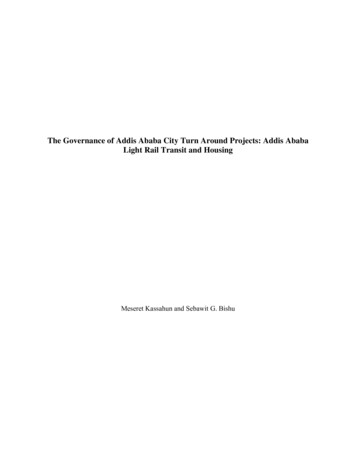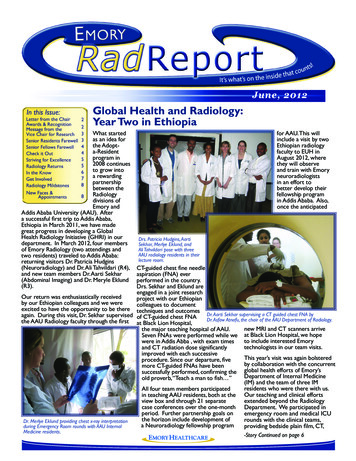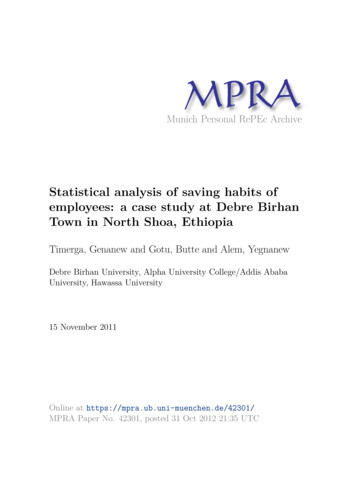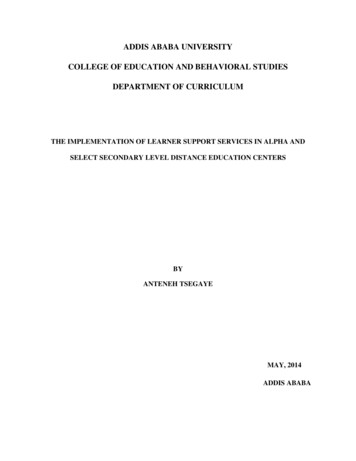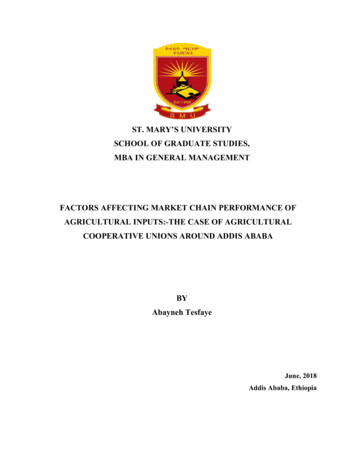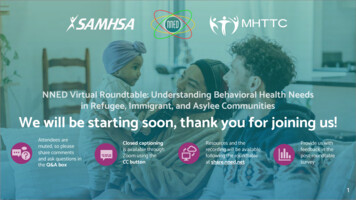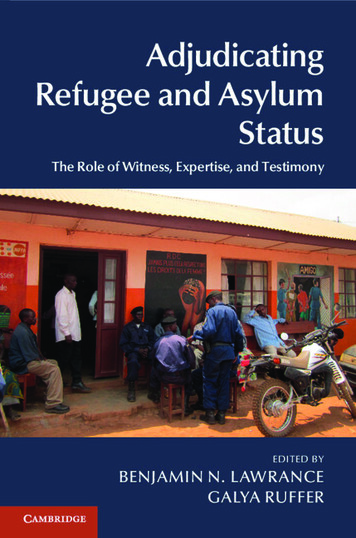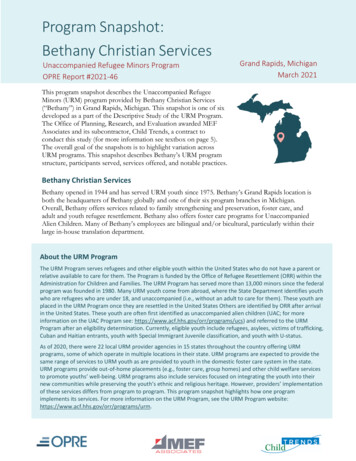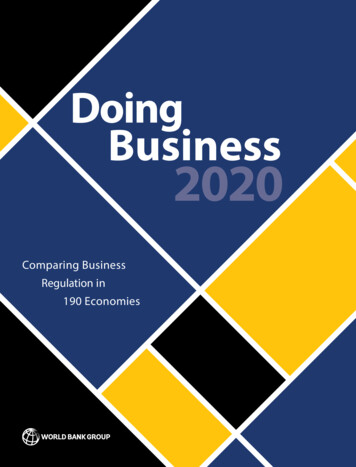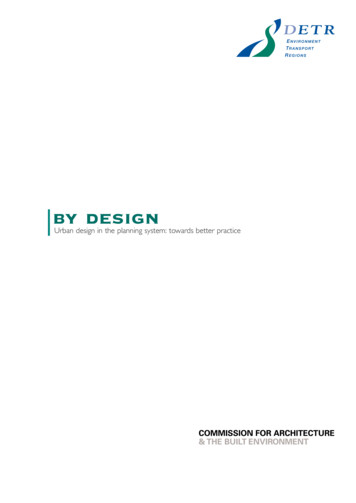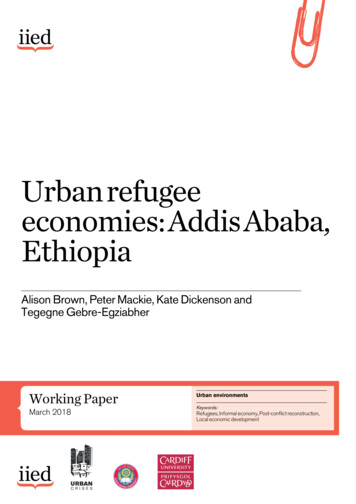
Transcription
Urban refugeeeconomies: Addis Ababa,EthiopiaAlison Brown, Peter Mackie, Kate Dickenson andTegegne Gebre-EgziabherWorking PaperMarch 2018Urban environmentsKeywords:Refugees, Informal economy, Post-conflict reconstruction,Local economic development
About the authorsAcknowledgementsAlison Brown, Cardiff own-alison,brownam@cardiff.ac.ukOur thanks to Addis Ababa University, in particular to TegegneGebre-Egziabher’s research assistants, the Administration forRefugee and Returnee Affairs (ARRA) and the Danish RefugeeCouncil who facilitated this research. Thanks also to JenniferRiggan, Arcadia University, and Kemisso Alebachew, Addis AbabaUniversity, for their support. Most significantly, our thanks to themany refugees who participated in this studyPeter Mackie, Cardiff ckie-peterKate Dickenson, Cardiff 5995-Kate-DickensonTegegne Gebre-Egziabher, Addis Ababa University,www.aau.edu.et/idpr/tegegneProduced by IIED’s Human SettlementsGroupThe Human Settlements Group works to reduce poverty andimprove health and housing conditions in the urban centres ofAfrica, Asia and Latin America. It seeks to combine this withpromoting good governance and more ecologically sustainablepatterns of urban development and rural-urban linkages.Partner organisationsCardiff University: the Informal Economy Research Observatoryat Cardiff University promotes research and action to understandand develop solutions for the informal economy: ervatory.Addis Ababa University: one of the university’s key specialismsis development studies, through which it seeks to generate indepth knowledge of social, economic, political and environmentaldevelopment challenges of Ethiopia and the wider world.Danish Refugee Council: DRC implements a broad range ofactivities relevant to conflict-affected communities and persons.DRC has operated in Ethiopia since 2009, supporting refugeepopulations and host communities.Published by IIED, March 2018Brown, A, Mackie, P, Dickenson, K and Gebre-Egziabher, T (2018)Urban refugee economies: Addis Ababa, Ethiopia. IIED, London.http://pubs.iied.org/10850IIEDISBN 978-1-78431-510-8Printed on recycled paper with vegetable-based inks.International Institute for Environment and Development80-86 Gray’s Inn Road, London WC1X 8NH, UKTel: 44 (0)20 3463 7399Fax: 44 (0)20 3514 oad more publications at www.iied.org/pubsIIED is a charity registered in England, Charity No.800066and in Scotland, OSCR Reg No.SC039864 and a companylimited by guarantee registered in England No.2188452.About the Urban Crises Learning FundUrban areas are increasingly the sites of humanitarian crises,from natural disasters to conflict and displacement. IIED is leadinga three-year programme of research, documentation of pastexperiences, development of tools and guidelines, and sharedlearning across humanitarian actors and other urban stakeholders.IIED is working to build the knowledge and capacity to respond ofhumanitarian actors working in urban areas, and of urban actorsfacing humanitarian crises. For more information, working papersand policy briefings see: www.iied.org/urban-crises-learning-fund
IIED WORKING PAPEROver 60 per cent of the world’s refugees live in urbanenvironments, but host governments often restrict theirright to work, forcing urban refugees into precariousand often informal economy livelihoods. Through acase study of Addis Ababa, where refugees haveno legal right to work, this research identifies theeconomic difficulties faced by urban refugees. Yet itfinds that refugee economies are highly integrated intothe city’s economy, making significant contributions.The research points to opportunities for humanitariansector actors to enhance refugee economies todayand in the future when Ethiopia implements its pledgeto enhance access to employment for refugees. Kate DickensonInformal businesses in the Bole Mikael area of Addis Ababawww.iied.org 3
URBAN REFUGEE ECONOMIES: ADDIS ABABA, ETHIOPIAContentsSummary61 Introduction81.1 The research1.2 Why Addis Ababa?1.3 Structure of the report8894 Findings274.1 Introduction4.2 Urban refugees in Addis Ababa4.3 Urban refugees and their livelihood strategies4.4 Linkages, impacts and contributions of refugeeeconomies27273042342 Refugee livelihoods in the international context105 Conclusion2.1 Tackling the urban problem2.2 Urban refugees2.3 Challenges for urban refugees2.4 Right to work: international approaches2.5 Urban refugee economies2.6 Humanitarian aid for urban refugees2.7 Urban refugees in Addis Ababa101012121517203 Methods233.1 Introduction to methods3.2 Semi-structured interviews with informal-sectorbusinesses3.3 Focus groups3.4 Key informant interviews3.5 Workshop235.1 Introduction425.2 Urban refugees in Addis Ababa425.3 Urban refugees and their livelihood strategies425.4 Linkages, impacts and contributions of refugeeeconomies445.5 Interventions to secure refugee economies in theabsence of a right to work445.6 Challenges and opportunities in the transition towardsa right to work455.7 Summary of conclusions464 www.iied.org23252525References47
IIED WORKING PAPERBoxes, figures and tablesBox 1. Right to work in action, EcuadorBox 2. Restricted right to work, EgyptBox 3. No right to work, Malaysia141414Figure 1. Typologies of right to workFigure 2. Map of Addis AbabaFigure 3. Businesses that employ refugeesFigure 4. Refugee businesses employing EthiopiansFigure 5. Ethiopians that would employ refugees if it were legalFigure 6. Ethiopians who buy from refugee businesses132430363638Table 1. Type of businessTable 2. Focus group participantsTable 3. Businesses employing refugeesTable 4. Type of refugee-owned businessTable 5. Gender of employees in refugee-owned businessTable 6. Refugee nationality by business typeTable 7. Refugee contribution to wider tion for Refugee and Returnee AffairsComprehensive Refugee Response FrameworkDanish Refugee CouncilEthiopian-owned businessEthiopian Orthodox Church Development and Inter-church Aid CommissionInternally displaced personJesuit Refugee ServiceKey informantLocal economic developmentNear East FoundationNon-governmental organisationNorwegian Refugee CouncilOut of Camp Policy (OCPs are Eritrean unassisted refugees who benefit from the policy)Opportunities Industrialization Centers EthiopiaRefugee-owned businessSustainable Development GoalsUnited NationsUnited Nations High Commissioner for Refugeeswww.iied.org 5
URBAN REFUGEE ECONOMIES: ADDIS ABABA, ETHIOPIASummaryWith a focus on the informal economy, this researchprovides new insights into urban refugee economiesand their contribution to market development in AddisAbaba – a city where refugees are, at least for the timebeing, not legally permitted to work. Refugee economiesare defined here as the economy created by urbanrefugees through their livelihood activities, enterprise,need for services and consumption, and throughrefugee support and diaspora inputs. While academicsand humanitarian agencies have focused on the role ofinformal livelihoods in supporting the survival of refugeehouseholds, the coalescence of refugee livelihoods into‘refugee economies’ – and the links with, and contributionsto, host economies – has not been widely researched. Thisresearch addresses this knowledge gap. W hat humanitarian interventions would help securerefugee economies and increase the linkages with localmarket actors in the absence of a right to work?Over 60 per cent of the world’s refugees live in urbanenvironments and while cities provide anonymityand access to urban resources, refugees often faceexploitation and discrimination in urban policy. Althoughhumanitarian agencies advocate for the right of refugees tolive and work in cities, host governments often restrict theirrights to work, forcing urban refugees into precarious andoften informal economy livelihoods. Furthermore, currenthumanitarian interventions designed to support refugees inovercoming challenges to sustainable livelihoods in citiesare insufficient. This undermines the resilience of refugeehouseholds, limits their prospects to claim ‘decent work’and ignores the potential of refugees to contribute to thehost city.Key findingsThrough a case study of Addis Ababa, this researchdevelops knowledge on refugee economies, identifiescontributions that refugees make to the local economydespite the significant challenges they face, andinvestigates the potential asset of refugee economies toinform humanitarian assistance in areas where refugeerights to work are restricted. While Ethiopia has one of thelargest refugee populations in sub-Saharan Africa (over794,130 in 2016), refugees are not legally permitted towork (UNHCR 2017b). However, Ethiopia is now a pilotcountry for the implementation of the United Nations HighCommissioner for Refugees (UNHCR) ComprehensiveRefugee Response Framework (CRRF) and the Ethiopiangovernment is re-examining refugee employment rights.Research in Addis Ababa was undertaken in April 2017and addressed four research questions: W hat livelihood strategies do different refugeecommunities in Addis Ababa adopt? H ow do refugee economies link with local economies inAddis Ababa and what are the wider market impacts andcontributions?6 www.iied.org W hat are the key challenges and opportunities in thetransition towards a right to work for urban refugees inAddis Ababa?The research drew on 195 key informant (KI) interviewswith owners of, and workers in, Ethiopian-ownedbusinesses (144) and refugee-owned businesses (51);focus groups with male and female refugees from Somalia,South Sudan, Eritrea, Yemen and the Great Lakesregion; key informant interviews; and a workshop withstakeholders in the city. A literature review also examinedthe existing state of knowledge.Urban refugees in Addis AbabaThere are an estimated 31,000 refugees in Addis Ababaconsisting of around 20,000 registered refugees, includingassisted refugees and Eritrean unassisted refugees(Eritrean unassisted refugees are also known as Out ofCamp Policy refugees or OCPs), and perhaps 11,000unassisted unregistered refugees (KI interview). Theserefugees represent 21 nationalities and have differinglevels of health, education and experience of the urbanenvironment. They have also integrated differently into thehost city with assimilation dependent on factors includingknowledge of Amharic, social networks, wealth, culturalaffiliation, physical traits, length of time in country of origin,inter-marriage with Ethiopians, religion and employment.This heterogeneity must be taken into account inresponses to the challenges and opportunities of urbanrefugee economies, meaning there can be no one-size-fitsall response.Urban refugees and their livelihood strategiesThough refugees in Addis Ababa have no right to work,informal work is generally tolerated, and the researchidentified four main income sources: Informal employment was widespread with Eritrean,Somali and Yemeni refugees employed in Ethiopianowned and refugee-owned informal enterprises.Refugees were also employed informally by formalorganisations, eg as nurses in private clinics or translators. R efugees ran informal enterprises in service provision,retail trade, leisure and hospitality, and construction.Some enterprises were run under the licence of anEthiopian. Refugee-owned enterprises varied in size andproductivity.
IIED WORKING PAPER H umanitarian assistance varied in form and indistributing organisations. All non-OCP registered urbanrefugees receive financial assistance from UNHCR(distributed monthly). Various non-governmentalorganisations (NGOs) also support urban refugeesthrough business grants and loans, and skills andbusiness training programmes. Remittances were highlighted as a vital income sourcefor urban refugees. However, access varied across andwithin different nationalities.Though informal work is generally tolerated, refugees faceconsiderable livelihood challenges: L imited access to employment is the most significantbarrier to securing refugee livelihoods. R efugees and Ethiopians both considered that the OCPpolicy should extend beyond Eritreans to include othernationalities. W ith no labour protections, refugees face workplacediscrimination that includes low wages or summarydismissal. L ack of access to business licences means mostrefugee-run businesses operate under the licence of anEthiopian business, limiting reinvestment and growthpotential. D iaspora links can be key in generating new enterpriseand internationalising the local economy.Interventions to secure refugee economies in theabsence of a right to workThe research points towards eight interventions to helpsecure refugee economies in Ethiopia’s current contextwhere there is no de jure right to work: Advocacy, E nabling self-help by creating a conducive environmentfor work, Addressing labour protection gaps, Strengthening representation, Appropriate business and skills training, Targeting illicit economies, I nclusion in local economic development (LED) policy,and Consumer protections.Challenges and opportunities in the transition towardsa right to workWith the transition from de facto to de jure rights to workimminent for at least some refugees in Ethiopia, thestudy identifies seven key challenges and opportunities M any refugees identified the lack of Ethiopian languageassociated with the transition:skills as a barrier to employment and wider assimilation. Bureaucracy related to gaining work permits, W omen refugees face particular challenges inmanaging childcare and income earning, and need The need to access business licences,additional support. Employment protections, V ulnerable refugees may be forced into undesirable A joint stakeholder platform,work such as prostitution and NGO help for these groupsis imperative. Anticipating and managing growth, D espite extensive government and NGO engagement,many urban refugees are isolated and strengtheningrepresentation is key.Linkages, impacts and contributions of refugeeeconomiesImpacts of refugee economies include: Business agglomerations are formed and createdynamic new markets. Refugees enhance existing enterprises by creatinglinks with host community enterprises and creating newcustomer and supplies bases. Maintaining a safety net, and Wider issues of integration.ConclusionRefugees in Addis Ababa face considerable economicdifficulties and pose many challenges for urban andnational authorities. Yet refugee economies are also highlyintegrated into the city’s economy and make significantcontributions. The research points to opportunities forhumanitarian sector actors to enhance refugee economiestoday, and in the future when Ethiopia implements itspledge to enhance access to employment for refugees. R eciprocal employment was common, as both local andrefugee businesses sought to reach customers in theirrespective communities. I nnovation is evident in refugee businesses creating newmarkets, the most notable being the import of perfume bySomali refugees.www.iied.org 7
1URBAN REFUGEE ECONOMIES: ADDIS ABABA, ETHIOPIAIntroduction1.1 The researchto market development in the host city. Based on fieldworkin Addis Ababa in April 2017 the research addresses fourkey questions:In 2015, forced displacement affected an estimated65.3 million people, including 21.3 million refugees, and W hat livelihood strategies do different refugee40.8 million internally displaced persons (IDPs) (UNHCRcommunities in Addis Ababa adopt?2016). Over 60 per cent of the world’s 19.5 million H ow do refugee economies link with local economies inrefugees and 80 per cent of 34 million IDPs live in urbanAddis Ababa and what are the wider market impacts andenvironments (UNHCR 2017a). Yet while cities providecontributions?refugees anonymity and the opportunity to work, refugeesin cities and towns face discrimination and exploitation and W hat humanitarian interventions would help securetend to be amongst the poorest urban residents (De Vriese refugee economies and increase the linkages with local2006), often working in the urban informal economy.market actors in the absence of a right to work?Despite the revised UNHCR policy, which cements the W hat are the key challenges and opportunities in therights of refugees to live and work in cities (UNHCRtransition towards a right to work for urban refugees in2009), host governments often limit the ability ofAddis Ababa?refugees to gain formal employment (Section 2.4). Thus,many refugees remain in ‘grey space’ (Yiftachel 2009),indefinitely positioned between legality and illegalityand marginalised in urban policy. Furthermore, currentEthiopia was chosen for study because it has one ofhumanitarian interventions designed to support refugees the largest refugee populations in sub-Saharan Africain overcoming challenges to sustainable livelihoods in(estimated at over 794,130 in 2016) and because it iscities are insufficient (Earle 2017). This undermines thea country where refugees are legally restricted in theirresilience of refugee households to recover legitimacyability to work (UNHCR 2017b). Ethiopia has an openin new settings, limits their potential to claim ‘decentdoor policy towards refugees, but there are no specificwork’ with adequate working conditions and socialprovisions in Ethiopian law for refugee integration andsecurity support, and ignores the potential of refugees to there are considerable restrictions on refugee freedomcontribute to the host city.of movement, with the government maintaining anencampment policy for the majority of refugees (UNHCRWhile academics and humanitarian agencies have2016). Addis Ababa has the largest concentrationfocused on the role of informal livelihoods in supportingof urban refugees in the country. However, like manythe survival of refugee households where the right todeveloping cities in sub-Saharan Africa, it has high levelswork is restricted, the wider economic impact of refugeeof unemployment and budget and resource constraintslivelihoods, enterprise, consumption and support referred(European Commission 2016).to in this report as ‘refugee economies’ has been under-1.2 Why Addis Ababa?researched (Section 2.5). Thus, the coalescence ofrefugee livelihoods into ‘refugee economies’ and the linkswith, and contribution to, host economies is largely absentin academic study.With a focus on the informal economy, this researchexamines urban refugee economies and their contribution8 www.iied.orgThe Ethiopian government is currently reassessing itsrefugee policy. The New York Declaration on Refugeesand Migrants, adopted by the UN General Assembly in2016, includes commitments to enhance the protectionof refugees and migrants. The declaration calls uponUNHCR to develop and initiate a Comprehensive Refugee
IIED WORKING PAPERResponse Framework (CRRF) in situations involving largemovements of refugees, in coordination with national andlocal authorities (UN General Assembly 2016). Ethiopia isa pilot country for the CRRF, and is currently implementingthe nine pledges made in 2016 in relation to education,land rights, local integration, and access to employment forrefugees.1 This research contributes to the pledge to extendaccess to employment. It adds to academic knowledge onurban refugee livelihoods and makes recommendations toenable and support refugee economies.1.3 Structure of the reportFollowing this introduction, Section 2 examines refugeelivelihoods in an international context. It investigates thecharacteristics of urban refugees and the challenges theyface, and assesses different typologies of the right towork for refugees and the lessons from implementation.It then summarises the concept of urban refugeeeconomies and their contribution before discussinghumanitarian interventions on urban refugee livelihoods.Section 3 briefly discusses the three-stage methodologyused in the fieldwork. Section 4 sets out the findingsof the report, and looks at the heterogeneity of urbanrefugees in Addis Ababa, examines the economic activityof refugees in the city, and the wider links and economiccontribution of these refugee economies. Section 5 setsout recommendations to support refugee economies inAddis Ababa. Kate DickensonStreet traders selling vegetables near Gofa1For a summary of Ethiopia’s pledges at the Leaders’ Summit on Refugees files/public summary document refugee summit final 11-11-2016.pdfwww.iied.org 9
2URBAN REFUGEE ECONOMIES: ADDIS ABABA, ETHIOPIARefugee livelihoodsin the internationalcontext2.1 Tackling the urbanproblemRecognising the urban-focused, protracted natureof refugee displacement, humanitarian assistancehas realigned its focus from large-scale repatriationprogrammes for camp-based refugees to include longterm interventions for marginalised urban refugees. Coreto this approach is the promotion of the concept of refugee‘self-reliance’, where refugees should be enabled topursue their own economic opportunities in host citiesin order to sustain themselves and their families (Omata2012).The right to work has been highlighted as being centralto self-reliance for refugees (Crisp et al. 2012). AlthoughUNHCR has set out explicit obligations for host countriesto allow refugees to live and work in cities, many hostgovernments still possess restrictive policies on refugeework. Furthermore, humanitarian interventions to supportrefugees in overcoming challenges to sustainablelivelihoods in cities remain insufficient (Earle 2017).This evolving humanitarian approach has generated aproliferation of literature on urban refugee livelihoods.This work has included discussion on urban refugeecharacteristics, the impact of hosting refugees on states,and constraints to refugee livelihoods. This literatureincludes critiques of the dichotomy between internationalpolicy promoting refugee work and restrictions at locallevel. However, until recently, there has been little on howrefugee livelihoods fit into the wider economic systems ofhost cities. Such ‘refugee economies’ have implications for10 www.iied.orgrefugees achieving self-reliance and contributing to hosteconomies, but remain significantly under-researched. Inparticular, the networked aspect of refugee economies andtheir positive or negative impacts on host economies hasnot been widely explored.This section examines the existing state of knowledgewithin the academic and humanitarian assistancecommunity on urban refugee livelihoods and refugeeeconomies in the global South, with particular focuson the informal economy. To this end, the informaleconomy includes both the informal sector (employmentand production in unincorporated, unregistered smallenterprises), and informal employment (ie employmentwithout social protection) (ILO 2013).From the literature, the section provides a profile ofurban refugees and the livelihood challenges they face;identifies the different approaches of the right to workand the lessons learnt from its implementation; analysesurban refugee livelihoods and economies in the globalSouth and their economic contribution; and assesseshumanitarian interventions on urban refuge livelihoods. Itconcludes with a summary of literature on urban refugeelivelihoods and humanitarian livelihood interventions inAddis Ababa.2.2 Urban refugeesAs the majority of refugees now live in towns and citiesthere is an increasing volume of work on urban refugeesin the academic, humanitarian and development fields.Inherent in the framing of a distinctly ‘urban’ refugeepopulation is the assumption that they differ from other
IIED WORKING PAPERdisplaced populations in host countries. However, the2.2.3 Refugees, IDPs and migrantsextent to which, and the ways in which, urban refugeesIn the UN’s 1951 Refugee Convention a refugee isdiffer from rural, camp-based refugees, urban-basedinternally displaced persons (IDPs) and economic migrants defined as someone fleeing their home because of fearof persecution for reasons of race, religion, nationality,has been debated.political opinion or membership of a social group. An IDP isdefined as someone who has had to leave their home as a2.2.1 Long-term exileresult of armed conflict, generalised violence, violations ofThe majority of refugees are now in a protracted refugeehuman rights or natural disaster but who has not crossedsituation, living in exile for at least five years and with noan internationally recognised state border. A migrant issign of a ‘durable solution’ (Crisp 2014; Crawford et al.defined as a person moving across an international border2015). Situations of displacement are varied and subjector from their normal place of residence regardless of theirto continuous change and there is rarely a predictable pathlegal status or whether the movement is voluntary or forcedfrom displacement to return, with most refugees displaced(IOM 2016).in the host county for over 20 years (Milner and LoescherRefugees, IDPs and migrants share much in common2011). For urban refugees, the humanitarian communitynow places increasing emphasis on local integration in the and often pursue urban living for similar reasons: betterhost city instead of repatriation or third-country settlement livelihood opportunities; improved service provision; and a(Dryden-Peterson and Hovil 2003). This process involves variety of recreational and intellectual activities (De Vriese2006; Campbell 2006; Buscher 2013). They often facethe gradual attainment of rights in the host city, creatingcomparable challenges in host cities (Section 2.3) butand sustaining livelihoods, and socio-cultural adaptationthat allows refugees to contribute to the social fabric of the can have similar impacts on host markets and populationshost city without discrimination or exclusion (Fielden 2008; (Maystadt and Verwimp 2014). There are, however, keydifferences between the groups.Crisp 2004).2.2.2 Camp and non-camp refugeesAs most refugees now live outside of identifiable campsor settlements, distinctions have been made betweenthe characteristics of camp-based refugees and noncamp refugees, the latter often living in urban areas.Some scholars point to the greater levels of vulnerabilityamongst those who live in camps as they are reliant ondirect assistance such as food aid and shelter (Landau2014; Kobia and Cranfield 2009; Jacobsen 2006) whileothers emphasise the greater agency of urban refugeeswho are generally more mobile, resourceful, educated andsocially connected (Macchiavello 2004; Crisp et al. 2012;Chatelard 2011).However, there has also been criticism of the presumeddichotomy between ‘reliant’ camp-based refugees and‘self-reliant’ urban refugees. Buscher (2013) has arguedthat many urban refugees arrive in cities via refugeecamps, making it difficult to distinguish the groups.Dryden-Petersen and Hovil (2003) see the city as moreconducive to sustainable livelihoods than closed campsor settlements where there are more limits on commercialactivity. On the other hand, urban refugees may not havethe option of humanitarian assistance, as the dispersalof refugees in cities makes humanitarian attempts toassist and protect them more difficult (UNHCR 2012). Afurther critique emphasises the difficulty in distinguishingurban refugees from migrants and members of the hostcommunity as refugees often disappear among longerterm residents who may share class, language, religious orother characteristics (Landau 2014). All of these critiquesquestion the assumption that urban refugees have theskills and means to help themselves without support (Earle2017; Crisp 2014; Buscher 2013).The forcibly displaced come from a position of loss withthe forfeiture of physical assets, social networks, health,and emotional wellbeing during displacement. Whilethey may receive humanitarian aid, such losses canleave forced migrants at an economic disadvantage inthe host city when compared with economic migrants(Jacobsen 2014). Of the forcibly displaced, refugees canbe more disadvantaged as ‘IDPs are citizens rather than“foreigners” and thus are not constrained by laws andpolicy pertaining to non-citizens’ (Jacobsen 2014) thoughIDPs from marginalised areas or groups or who receive noinstitutional recognition can also be disadvantaged.2.2.4 Urban refugees – a mixedcommunityThere has been criticism of grouping urban refugeestogether as it assumes they are a ‘distinct populationwith economic and social identities shaped primarily orexclusively by their displacements’ which can reinforceperceived and actual differences between refugees andtheir host community (Landau 2014). This, in turn, canfoster resentment and initiate exclusionary policy in theurban environment.In practice, urban refugee communities have very differentsocio-economic profiles, and refugees have very differentvulnerabilities and economic potential within differenturban contexts (Betts et al. 2014; Buscher 2013;Crawford et al. 2015; Kobia and Cranfield 2009).Layers of new, old, or oft-displaced people a mishmashof wildly differing needs and social and human capitalamongst the displaced and their hosts; and opaquesystems of support – sometimes international, more oftenlocal and informal (Crawford et al. 2015).www.iied.org 11
URBAN REFUGEE ECONOMIES: ADDIS ABABA, ETHIOPIAThese variables affect the ability of urban refugees tocreate and sustain livelihoods. While most refugees havelost considerable assets through displacement, someassets – in particular social, human and financial capital– remain (Buscher 2013). These can include highereducational attainment, wider social networks or accessto finance from remittances, all of which help towardsself-sufficiency (Pavanello et
URBAN REFUGEE ECONOMIES: ADDIS ABABA, ETHIOPIA 4 www.iied.org Summary 6 1 Introduction 8 1.1 The research 8 1.2 Why Addis Ababa? 8 1.3 Structure of the report 9
